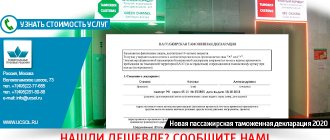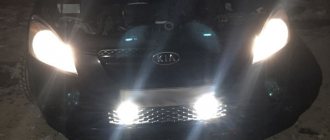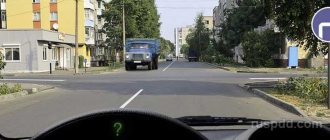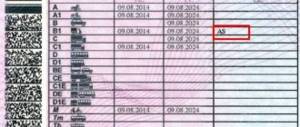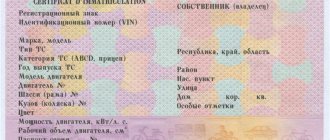Categories of self-propelled vehicles
Self-propelled transport includes cars that require category “A”, “B”, “C”, “D” or “M”. Almost each of these categories has subcategories that more fully characterize the engine size and the ability to travel on such a vehicle. For example, Category “A” allows you to control motor vehicles that are not intended to travel on general purpose highways or have a high speed limit. It should not exceed 50 km/h.
Such transport includes:
- snowmobiles,
- quads,
- swamp walkers,
- motorcycles,
- off-road cars,
- airport apron buses and some other transport.
However, there are some subcategories that also need to be taken into account. Thus, the designation “A1” will indicate the ability to travel only on off-road vehicles, such as a moped, ATV or snowmobile. This subcategory is popularly called the tractor driver permit.
ATTENTION !!! Subcategory “A2” will talk about the ability to travel on off-road vehicles weighing up to 3.5 tons. In this case there should not be more than 8 seats for passengers.
Subcategories “A3” and “A4” will allow you to drive an off-road vehicle with a total weight exceeding 3.5 tons, but at the same time, cars of the subcategory “A4” are used to transport passengers.
Old norms legalized
To drive special equipment that is not intended for driving on regular roads, you need to obtain a tractor driver’s license.
Snowmobiles and ATVs are registered by the State Technical Inspectorate, so these vehicles must undergo technical inspection. These norms have already become a legislative act at the level of government regulations. On the other hand, due to the different rules of individual regions, individual norms need to be more clearly defined.
Now, for violating the rules under Article 9.3 of the Code of Administrative Offenses of the Russian Federation, a fine of 100-300 rubles is provided. Soon the administrative penalty is planned to be increased to 1,000 rubles.
According to the new law, self-propelled vehicles include:
- tractors;
- agricultural machinery;
- utilities;
- as well as motor vehicles, which are equipped with an engine capacity of more than 50 cubic centimeters and an electric motor with a power of more than 4 kW.
To obtain these rights, you still need to undergo vocational training and pass exams in the prescribed manner. The procedure for registration and technical inspection of these vehicles will be approved by the government. It is planned to introduce an electronic passport for self-propelled vehicles.
To register, you must have compulsory motor third party liability insurance. Today, it is not necessary to prepare such documents for vehicles that are not intended for movement on public roads.
Category "B"
This category of vehicles includes tracked or wheeled vehicles, the engine power of which will not exceed 25.7 kW. It is usually opened for travel by passenger cars that can carry up to 8 passengers. Vehicles cannot have a total weight exceeding 3.5 tons. Category “B” also includes driving mini-tractors and mini-excavators. The most common words are “excavator operator” or “forklift operator”. If the vehicle is used with a trailer, then it is better to take care of opening the “BE” subcategory.
Classification of self-propelled vehicles by category
This division is regulated by the same Rules that were approved by the Government of the Russian Federation on July 12, 1999, by Resolution No. 796. It lists the categories into which these types of equipment are divided. What does it mean? The fact that, if necessary, to drive a particular car, the driver must first open the appropriate category in the “licence”. To do this, you need to pass exams at the Gostekhnadzor department and pay a state fee. The license will indicate not “driver”, but “driver”.
Classification of equipment:
- Category A. This includes vehicles that have a “maximum speed” of 50 km/h or less or do not have access to public roads. Has an additional classification: off-road motorcycles (including snowmobile and ATV); off-road vehicles with a maximum weight of up to 3.5 tons and accommodating up to 9 seated passengers (with driver). For example, small all-terrain vehicles; off-road trucks (over 3.5 tons); off-road buses (more than 9 seats).
- Category B. Wheeled and tracked vehicles, the engine power of which is up to 25.7 kW. For example, a mini excavator or a mini tractor (but not a walk-behind tractor).
- Category C. Wheeled (not tracked!) vehicles with power from 25.7 to 110.3 kW. An example is the MTZ-80 Belarus tractor.
- Category D. This includes any wheeled vehicles with a power of more than 110.3 kW. For example, the mighty K-744 Kirovets tractor.
- Category E. Tracked vehicles with an engine power greater than 25.7 kW. This, in particular, is a bulldozer or snow and swamp-going vehicle like the GAZ-3409 “Beaver”, which is built using a body from Sobol.
- Category F. Agricultural devices. Simply put, any combine – forage harvester, beet harvester, grain harvester, etc. belongs to this category.
Machines that have a pneumatic drive are classified according to the same criteria as others.
The category of rights to a forklift is determined by its capacity. For small mechanisms this is A, but there are also those that meet the parameters of category B or C. It is unlikely that there will be a roller that fits into A. Usually the roller fits category B, C or D.
In order to drive a crane that is installed on a vehicle chassis and perform work related directly to the crane, you need, in addition to a category C driver’s license, to also obtain a category D tractor driver’s license.
Category "C"
When this category opens, drivers on wheeled vehicles with an engine power potential not exceeding 110.3 kW have the opportunity to travel. Most trucks can be classified as this type of transport. At the same time, subcategory “C” will be available to drivers whose transport does not exceed 3.5 tons. To drive a vehicle weighing up to 12 tons, you will need to open the subcategory “C2”, and above this weight - “C3”. If vehicles are used with a trailer, then it makes sense to open the “CE” subcategory.
Categories of tractor driver rights
A tractor driver's license does not allow you to drive all known tractors; categories and subcategories of rights have been introduced to classify the types of permitted equipment. This certificate specifies 6 main categories and 4 subcategories:
- Category “A” allows you to drive motor vehicles that are not used and are not intended for driving on regular roads:
- subcategory I is used for driving off-road motor vehicles;
- subcategory II for off-road vehicles, with a mass of not more than 3500 kg with no more than eight seats excluding the driver's seat;
- subcategory III for off-road vehicles weighing more than 3500 kg, but this group does not include vehicles of subcategory IV;
- subcategory IV for off-road motor vehicles that are designed to transport people with more than eight seats, excluding the driver's seat.
- Category “B” is intended for tractors on wheels and tracks, whose power reaches and does not exceed 25.7 kW.
- Category “C” is used for tractors on wheels with a power from 25.7 kW to 110.3 kW.
- Category "D" is intended for wheeled tractors with a power of more than 110.3 kW.
- Category "E" is used for tractors on tracks with a power of more than 25.7 kW.
- Category “F” is intended for self-propelled rural vehicles, as well as combine harvesters.
What do special marks mean and why are they needed?
The driver of agricultural equipment undergoes training, like other motorists. The training program will differ significantly from learning to drive a conventional vehicle. For example, to become a tractor driver, you must undergo a training process of 2.5 months. In this case, the driver of a loader up to 4 kW does not need special marks. It is enough for him to have a forklift certificate. The cost of such a document is much lower, and the training period is shorter. The savings here, however, are relative. If ordinary rights need to be changed every 10 years, then annual testing is provided for this document.
ATTENTION !!! The assigned rank to the driver also plays an important role. It is usually indicated at the end of the course. Motorists of category “B” will have the 3rd category, and category “C” will have the 4th. The absence of a certificate of completion of these special courses may serve as a basis for verification of authenticity rights.
Recovering a lost document takes a lot of time and takes a lot of effort. In addition, some driving schools may close over time, which will significantly complicate the process of obtaining a duplicate.
Warehouse workers operating forklifts, electric pallet trucks or stackers must have valid medical certificates. They must indicate the absence of contraindications for driving this type of transport.
When undergoing a mandatory driver's medical examination, the driver must inform the commission about the relevant category he has. This will help save him from numerous checks and troubles in the workplace.
What are the requirements for motorists?
To be admitted to theoretical and practical testing, the driver must complete a certain number of hours of training. He will need to ensure that he has a certificate of the appropriate form. This document should not contain any contraindications for driving a vehicle of the selected category.
Opening a certain type of category, perhaps with the achievement of the required age, or requiring driving experience. For example, for category “A1” the driver must be 16 years old. Access to driving under category “A2” can only be issued after reaching the age of 19. For categories “B”, “C”, “E” and “F” you must be 17 years old.
Basic requirements for drivers
To obtain all of the categories of rights listed above, the driver must meet certain requirements.
To be admitted to the exams you will need:
- Complete specialized training and receive professional basic or additional education. Programs are being studied that are directly or indirectly related to the management of self-propelled vehicles of the listed categories. After completing the courses, you will receive a corresponding document confirming the assigned qualification.
- Pass a special medical examination to obtain a medical certificate. The document must confirm the complete absence of medical contraindications for driving self-propelled vehicles.
Each category of rights requires an appropriate age and a certain length of work experience:
- Category AI - from 16 years old;
- Category A II - from 19 years old, 12 months of experience in automobile category B;
- Category A III - from 19 years old, 12 months of experience in category C;
- Category A IV - from 22 years old, total experience of 12 months for category D driving license;
- Category B, C, E, F—from 17 years old;
- Category D - from 18 years old.
Only if all of the above conditions are fully met can you undergo special training and pass the relevant exams.
Our lawyers know the answer to your question
Free legal advice by phone: in Moscow and the Moscow region, in St. Petersburg, as well as throughout Russia
. After this, the driver is assigned a date for passing the exams. First, he will have to pass the theory, which includes 20 questions. If the driver answered all of them correctly or made only a couple of mistakes, he is allowed to take the practical test. If you fail to pass the exam the first time, do not despair or panic. A retake can be scheduled in as little as a week. During this period, the driver will be able to fill in the gaps in his knowledge.
When mistakes were made again during re-testing, the driver will be able to retake the theoretical part. After successfully passing the driving practice, he will be issued a license. This year, the certificate is obtained using a simplified system. Many State Traffic Inspectorate offices are fully automated, so the driver does not need to provide a photo. It is better to first clarify this issue with the authority responsible for issuing rights, but it is very rare to find a non-automated service in our country.
Payment of state duty
For the issuance of a new license, the driver will have to pay 2,000 rubles. In this case, it does not matter at all whether he receives them for the first time or opens a new category. Wanting to acquire an international license, the driver will have to spend 3,000 rubles. You can pay the state duty through self-service terminals, electronic wallets, a bank card, at the post office, on the State Traffic Inspectorate website or through the State Services portal. The last option will be preferable for many drivers, because in this way they can save up to 30% of the payment. When paying the state duty by other means, the driver will need to pay the full amount.
It is very important for the driver to have permission to drive the appropriate type of transport. In this case, offenders will face serious administrative penalties. Only compliance with traffic rules will help you avoid significant fines and save time and effort. When driving a car without the appropriate category, when the offender is stopped by a representative of the State Traffic Inspectorate, a protocol will be drawn up. The driver will face a significant administrative penalty, as well as the evacuation of the car to a fine area. The unpleasantness of the situation is aggravated by the fact that payment for tow truck services and storage at a specialized vehicle parking lot also falls on the driver.
IMPORTANT !!! For driving a vehicle without the appropriate category, the penalty can reach 15,000 rubles. The only exception is training driving in a specially equipped car with an instructor. The tow truck fee can be up to 2,000 rubles, and every day the car is stored at a fine site will increase the amount that will have to be paid quite significantly. Given this information, it is much easier and cheaper to obtain a license of the appropriate category, rather than spending huge sums on releasing your car or paying fines.
Avoiding the need to incur significant financial losses is quite simple. To do this, you need to travel, following all traffic rules strictly. Only in this case can the driver count on a safe and comfortable ride in the city or on the highway.
Important points on self-propelled vehicles
You need to know what categories self-propelled vehicles are divided into and what licenses you need to obtain. The level of security in companies and organizations depends on this.
To drive such vehicles, you must obtain special licenses.
Traffic police officers classify driving self-propelled vehicles with an inappropriate license as driving without a license. Responsibility for violating this rule can be not only administrative, but even criminal.
If the violations are serious enough, not only the perpetrators of the violations and crimes, but also the managers of the companies in which they work can be held accountable.
Punishments are imposed on them for the reason that they allowed the equipment to be controlled by people who do not have the right and proper skills to do so.

